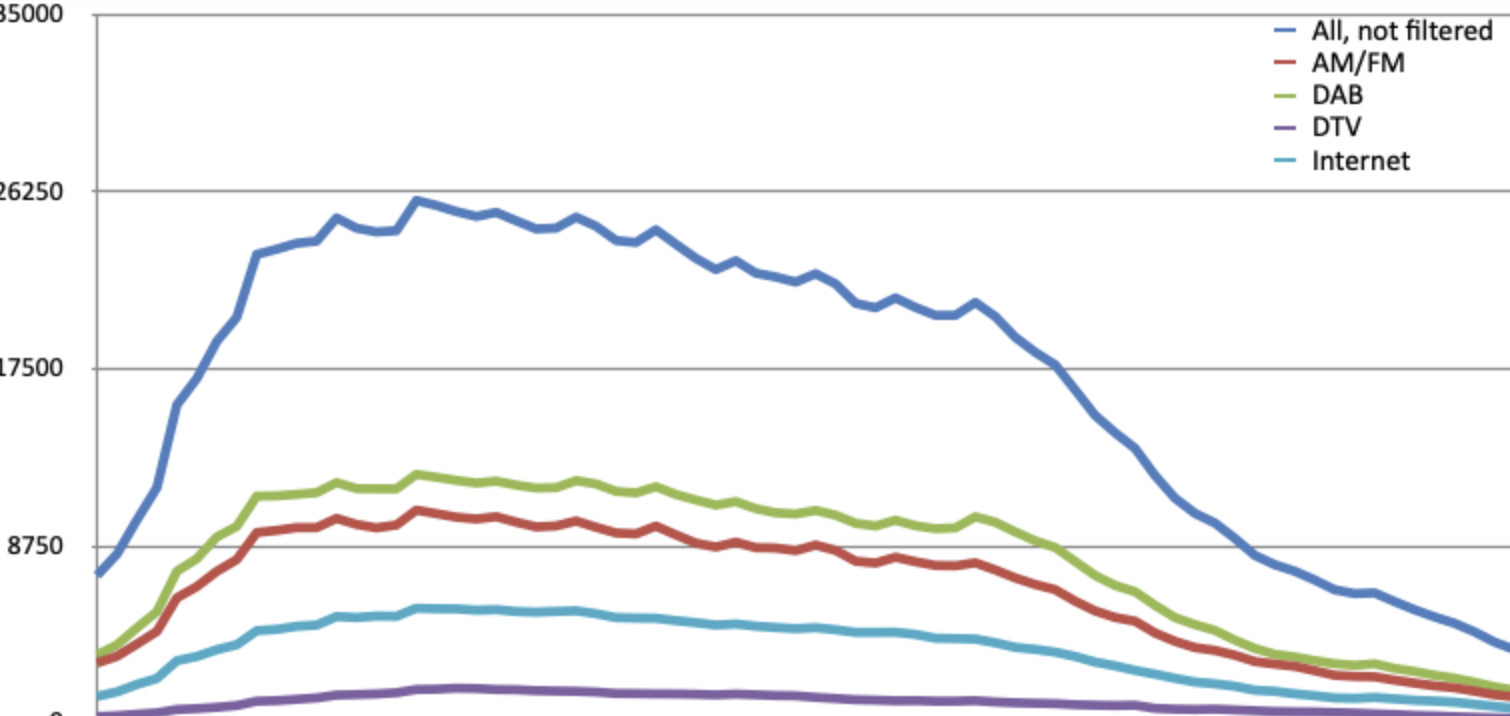
Opinion blog on the return of RAJAR, by Matt Deegan.
The latest RAJAR data is out, and there’s a lot in there. An 18 month wait, massive consumer change because of the pandemic alongside gradual consumer changes happening anyway, new stations, network re-brands, new talent. Plus all the normal ups and downs. Phew. I can’t cover it all in here, so you get the best of what I’ve noticed in a few hours.
The other important thing to notice is that RAJAR has changed how it measures audience figures. As I talked about earlier in the week there’s a broader methodology. For this reason, like for like comparisons of data are not really fair. However it’s hard to talk about the data without mentioning changes. It’s therefore up to you, dear reader, to keep that in mind as I talk about old and new data below.
Changing Behaviour
The thing that interests me the most is how consumer behaviour alters. Radio station output impacts that, but so do other developments in the world – phones, streaming, smart speakers etc. We’ve also had 18 months where we’ve been forced to do things differently. Indeed, many people won’t be going back to how it was in the before-times, mixing work from home and in the office. That changes what you listen to where. If you’re listening at all.
Let’s look at when people now listen. This is reach on the Y axis, and 15 minute segments along the X for weekdays. Pre-pandemic (Q1/2020), the breakfast peak was at 8am, with a small Drive peak between 4pm and 5pm.
If we switch over to this quarter (Q3/2021), the Breakfast peak is now at 10am, with a smaller drive peak at 4pm. This is the same for 15+ and for 25-34s.
The data also shows how daytimes are far more resilient too.
Why is this? Well when you look at where people listen to the radio, a pattern emerges. Here’s the Q1/2020 data. At home in blue, cars in red and work in green.
And here’s the same data for Q3/2021:
At work has dropped back, as has in-car (particularly at the previous ‘drive’ peaks) and home has grown.
Breaking this down to 25-34s, a core commercial radio target, and a key worker group, shows this change in greater relief. Q1/2020 on the top, Q3/2021 on the bottom.
Right now at home and broader morning listening is core. With people tuned in at home, I’d guess that they’re also listening in longer chunks and probably more intently than the rushing around the older data shows. If you haven’t changed your programming since the pandemic, or put it ‘back’ to what it was once, I think you’re missing a trick and probably making a mistake.
Platforms
This shift to at home listening has already accelerated multi-platform radio consumption.
Analogue radio hours (that’s AM and FM listening) now account for just a third of all radio listening (34.2%). Only 57.3% of the country *ever* listen to an analogue radio nowadays. DAB on its own accounts for 43% of listening hours and is the most popular platform, with 60.2% of the country tuning to the radio that way each week. Internet (apps, online and smart speakers) is pretty good too, with an 18.1% share of listening and 32.5% of consumers listening to some form of radio through the internet each week.
Clearly internet listening is growing and smart-speakers have been a big part of that. I was interested to look at two new stations (with no ingrained platform history) to see how people were tuning in. For Times Radio, their hours are two-thirds DAB, and one-third internet and for Boom Radio their split is 50/50 DAB and Internet.
Youthquake
Where the radio data does worry me is for younger listeners.
Reach-wise there has been a gradual decline. 5 years ago there were 6.6m listeners, now there’s 5.9m. However, since 2019, Facebook has seen teenage use for their app drop 13%. 15-24s in radio, on the other hand, only dropped 3% over the same period. So I’m not saying there aren’t any problems, but the declines perhaps aren’t as bad as the narrative and youth changes are affecting all media.
The problem isn’t really that they don’t listen to radio, it’s that they just don’t listen to it as much. In the last five years 15-24s have reduced their radio listening by 40%. Between now and the last RAJAR, the drop’s been 17%.
Older audiences have always been more voracious consumers of radio. Five years ago 45-54s listened to twice as much radio as 15-24s, but now the youth decline means it’s three times as much.
Taken together this also means the young are listening to less radio stations. In 2016 15-24s listened to 3.4 stations, they now choose 2.8. For youth stations this is why their reach is dropping. There’s less audience, they’re listening to less stations and their spending less time tuning in.
It’s perhaps no surprise that Radio 1 and Kiss had pretty bad results. Radio 1 reach dropping from 8.9m to 8.2m, Kiss down from 3.5m to 2.7m. Capital seemed to somewhat whether the storm, with a reach increase to 6.5m from 6.3m. However they still saw big 15-24 drops. They were just insured by increases in older demographics.
Other youth stations like 1Xtra and Capital Xtra had similar bad books.
The output, and recent changes, for Radio 1 and Kiss have been good. I think there’s probably a wider existential problem for young audiences, and I’m not sure we’re seeing the radio sector tackle it in a big way.
Older Audiences
For radio groups, older audiences provide larger listening opportunities. Radio 2 and Radio 4 are older skewed and now Greatest Hits Radio has rebranded stations of appeal to under 45s, with a brand more interesting to 40 plus. At the same time new stations to super-serve older audiences, like Boom Radio, have appeared mainly appealing to 65 pluses.
I’ve been intrigued by the re-brand of stations like The Eagle, Minster FM and the Breeze as Greatest Hits Radio. For the heritage ILRs they were replacing, it was a significant format change from a broad local pop service to a networked oldies one. I couldn’t see how this change wouldn’t decimate the reach and hours of these stations. Generally, with the best will in the world, a big change is always likely to create significant churn.
However, looking at all the stations that have changed together, it’s on the face of it, fairly static. Reach has dropped about 130k (to 1.6m), but the total hours have been the same – 12.5m. It’s when you break it out, though, that the real information shows up.
The stations that had strong brand identities and heritage before – the Spires, the Eagles, the Rother FMs of the world – have taken an audience hit of 10% to 30%. The stations that were poorer, or had little investment, or were on a merry-go-round of rebrands, have had their figures transformed the other way. For those, becoming GHR was definitely an upgrade.
In London, GHR replaced Absolute Radio on 105.8 FM, though obviously Absolute was still available on the digital platforms in the capital and on its old AM frequencies, so I was interested to see what happened.
Before the change, Absolute delivered 1,528k hours on analogue and 4,058k on digital (GHR delivered 438k hours on digital). So 5.5m for Absolute and 438k for GHR. An overall Bauer total of 6m.
After the change, Absolute was down to 687k on analogue, but digital also dropped to 2.6m. GHR delivered 900k on analogue and 1.7m on digital – 2.6m in total. An overall Bauer total of 5.9m.
So again, pretty much a no score draw. Clearly all Absolute’s listeners won’t have moved to GHR, they would have churned some off, and attracted some new ones. It’s perhaps noticeable that Radio X (also on FM in London) had some of its best figures in the capital, going from 2.9m hours to 4.1m over the same period.
The analogue switch clearly prompted lots of trial. Absolute somewhat got the duff end of that deal as taking away a service from listeners (on FM) meant they shopped around and then moved some of their digital listening too. For GHR it was good news, as they got lots of forced trial from ex-Absolute FM listeners as well as more general promoting to new target audiences. The trick now will be for Absolute to claw back some of its old listeners and GHR to encourage more trial.
Absolute can however celebrate with the highest ever numbers for their network of stations reaching 5.2m people.
New Stations
Other new entries into the RAJAR charts were Boom Radio, with 233k reach, Times Radio with an impressive 637k reach and Capital Dance with 287k, though I imagine they’ll be a little disappointed with that.
Sister stations Capital Xtra and Capital Xtra Reloaded also recorded some poor figures. I think all three stations face the struggles of appealing to the declining 15-24s in the market and the soft-ish results of 25-34s too.
In other news…
Radio 4 and Radio 2 continue to be pretty unstoppable, with static, high figures. A good book for Radio 3 (Proms tends to help), 6Music (always the case before you make schedule changes!) and 5Live was back up to 5.9m after lolling in the 4.9 to 5.5s since 2018.
The Heart network did well with 8.5m reach and 53m hours, pretty much the highest they’ve had for a long while. LBC did well with 2.5m reach for the main station and 800k for their LBC News service. The main LBC’s average hours of 10.5 is also delivering stonking total hours of 27.2m (not far from 5 Live’s 35m hours but with half the reach.
Overall the figures were pretty good for the radio sector, with lots of good news, and general coping with the change in listener behaviour. The youthquake though, that has me worried.
AOB
- If you want even more RAJAR. I caught up with Phil Riley from Boom Radio, Anne Charles from Techcon and Stig Abel from Times Radio on The Media Podcast, a new episode should have just dropped, which you can listen to here.
Subscribe to Matt’s blog to read more like this.
Posted on Thursday, October 28th, 2021 at 12:01 am by Guest






